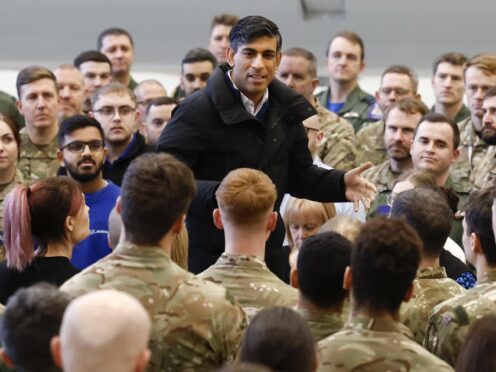Rishi Sunak said the UK is playing a “leadership” role in Nato despite coming under intense pressure to further increase defence spending.
The Prime Minister has committed to boost spending to 2.5% of gross domestic product – a measure of the size of the economy – but only when the public finances allow, despite pressure from defence experts and his own MPs to go further and faster.
During an LBC Radio phone-in, Mr Sunak was questioned by an Army veteran who urged him to “spend more than the minimum on defence”.

Russia’s invasion of Ukraine, instability in the Middle East, and an increasingly assertive China have all added to pressure on the Prime Minister to boost the defence budget.
Mr Sunak said: “The world is sadly a less certain and a less safe place and it’s important that we invest to keep the country safe. That’s what we’ve been doing… We’ve seen the largest increase in defence spending since the end of the Cold War. I authorised that as chancellor.”
He said the UK is spending around 2.3% of GDP on defence, with only the US in Nato spending more and many members not meeting the alliance’s 2% spending target.
Eighteen members of the 32-strong alliance are expected to spend 2% of GDP on defence in 2024 – a six-fold increase since 2014, when only three met the target.
Mr Sunak went on: “There are dozens of other members of Nato who are not even spending the 2% – we have shown British leadership on this. Our job is always to set a lead and that’s what we have done.”

The issue of Nato allies sharing the financial burden for protecting Europe is likely to become more urgent with the prospect of Donald Trump, who has been critical of the alliance, potentially returning to the White House.
The UK’s own commitment has become a domestic political issue for Mr Sunak as he seeks to maintain Tory unity and protect his leadership as the party struggles in the polls.
Defence Secretary Grant Shapps lobbied for extra funding in the March Budget but failed to get the increase he sought.

In March, deputy chief of the defence staff Lieutenant General Sir Rob Magowan said he will have to manage the “operational risk” that comes with not having the resources he would like, with the UK unable to fight a sustained war with Russia.
The senior Royal Marines officer said: “We’ve been very clear that the amount of money we’re spending on munitions at the moment – which is significant – does not meet, in all areas, the threats that we face.”
Former defence secretary Ben Wallace and ex-armed forces minister James Heappey have also pushed for an increase in spending.
Earlier this month Mr Wallace claimed some in Government are “just hoping” threats to the UK “will go away”, while Mr Heappey warned the UK has failed to prepare for war as a “whole-nation endeavour”.
